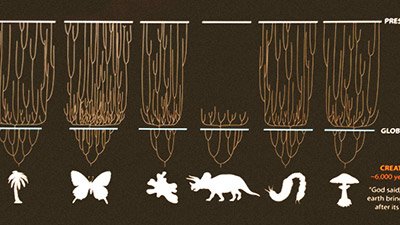
Snails Go On the Offensive
The venom gland in a poisonous mollusk sheds light on the origin of defense/attack structures.
News Source
- Science: “ScienceShot: How the Snail Picked Its Poison”
Predatory marine cone snails paralyze their prey with neurotoxic peptides delivered through a harpoon-like tooth. The venom gland originates late in metamorphosis by “rapidly pinching off” a ventral channel from the esophagus. In other mollusks, a similar structure develops into mucous glands or digestive enzyme glands.
This esophageal “out-pocketing has no function in larvae,” but it differentiates into the venom gland while the larva continues to feed through the other esophageal channel. Developmental biologist Louise Page dissected many snail larvae to find the elusive origin of the gland. She notes that this non-disruptive modular development of the adult venom gland addresses “a core issue for evolutionary biology: how can any component of a complex system change during evolution without disrupting the functional integrity of the whole?”2
The evolutionary scenario is limited by the irreducible complexity of the system: all parts—harpoon tooth, venom sac, and neurotoxic peptides—must already be present before the feeding system would be selected for preservation.
While the harmlessness of the out-pocketing meets one criterion for a successfully evolving structure, the fact that it offers no survival advantage until the poisonous enzymes develop argues against the evolutionary paradigm. The evolutionary scenario is limited by the irreducible complexity of the system: all parts—harpoon tooth, venom sac, and neurotoxic peptides—must already be present before the feeding system would be selected for preservation.
This development represents not evolution, but speciation, as well as the apparent expression and preservation of a defense/attack structure. Just as thorns and thistles are modifications of other plant parts, so the cone snail’s venom sac is a modification of a larval structure which develops in other snails to become more benign structures.
An organism’s genome typically contains more information that it expresses. The genes producing the venomous destiny for the esophageal out-pocketing may have well been present in the original created genome. Their noxious expression awaited God’s curse on His creation. And by equipping cone snails to, at some point in time, expand their diet to include their neighbors, God enabled them to compete successfully in a hostile world and pass this trait on to their offspring, producing the 500 extant cone snail species we see today.
Further Reading
For More Information: Get Answers
Remember, if you see a news story that might merit some attention, let us know about it! (Note: if the story originates from the Associated Press, FOX News, MSNBC, the New York Times, or another major national media outlet, we will most likely have already heard about it.) And thanks to all of our readers who have submitted great news tips to us. If you didn’t catch all the latest News to Know, why not take a look to see what you’ve missed?
(Please note that links will take you directly to the source. Answers in Genesis is not responsible for content on the websites to which we refer. For more information, please see our Privacy Policy.)
Footnotes
- Louise R. Page, “Developmental Modularity and Phenotypic Novelty Within a Biphasic Life Cycle: Morphogenesis of a Cone Snail Venom Gland,” Proc. R. Soc. B (May 18, 2011): doi:10.1098/rspb.2011.0501.

Answers in Genesis is an apologetics ministry, dedicated to helping Christians defend their faith and proclaim the good news of Jesus Christ.
- Customer Service 800.778.3390
- Available Monday–Friday | 9 AM–5 PM ET
- © 2025 Answers in Genesis

